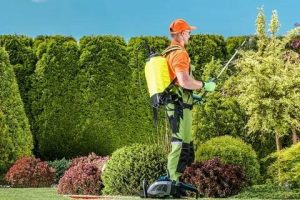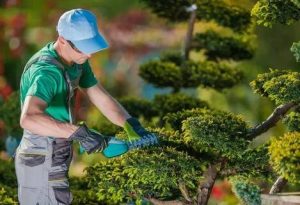
Landscape maintenance refers to the ongoing care and management of outdoor spaces, such as gardens, lawns, parks, and other landscaped areas. It involves a range of tasks aimed at preserving the health, functionality, and aesthetic appeal of the landscape. Some common landscape maintenance activities include:
Lawn care:
Lawn care is one of the key landscaping activities that focuses specifically on the maintenance and improvement of a lawn or grassy area. It involves a range of tasks aimed at promoting healthy growth, maintaining an attractive appearance, and ensuring the functionality of the lawn. Here are some common lawn care activities:
- Mowing: Regularly cutting the grass to an appropriate height to encourage healthy growth and maintain a neat and even appearance. The frequency and height of mowing may vary depending on the grass type and season.
- Edging: Creating clean and defined borders between the lawn and other landscaped areas, such as flower beds, sidewalks, or driveways. This helps give the lawn a well-groomed and polished look.
- Watering: Providing the lawn http://sbevolutionlandscape.com with adequate water to promote healthy growth and prevent wilting. The frequency and duration of watering may depend on factors such as weather conditions, grass type, and soil moisture levels.
- Fertilizing: Applying fertilizers to supply essential nutrients that support the growth and overall health of the grass. This can help enhance the color, density, and resilience of the lawn.
- Weed control: Implementing measures to prevent or eliminate weeds that can compete with the grass for nutrients, water, and sunlight. This may involve manual removal, herbicide application, or adopting cultural practices that discourage weed growth.
- Aeration: Creating small holes in the soil to improve air circulation, water infiltration, and nutrient absorption in the lawn. Aeration helps alleviate soil compaction and promotes a healthier root system.

Plant care:
Plant care is a vital aspect of landscaping that focuses on the health, growth, and aesthetics of plants within a landscape. It involves various activities aimed at promoting the well-being of plants, ensuring their proper development, and maintaining their visual appeal. Here are some common plant care activities:
- Pruning and trimming: Removing dead, damaged, or overgrown branches, stems, or foliage to enhance plant health, shape, and appearance. Pruning also helps improve airflow and light penetration.
- Watering: Providing plants with adequate moisture according to their specific needs. Proper watering helps prevent dehydration or overhydration and promotes healthy growth.
- Fertilizing: Supplying plants with essential nutrients through the application of fertilizers. Fertilizing helps enhance plant vigor, flowering, and overall health.
- Mulching: Applying a layer of organic material, such as wood chips or compost, around the base of plants. Mulching helps retain moisture, suppress weed growth, and regulate soil temperature.
- Weed control: Removing weeds from around plants to prevent competition for nutrients, water, and sunlight. Regular weeding helps maintain plant health and reduces the risk of diseases and pests.
- Pest and disease management: Identifying and addressing pests or diseases that may affect plants. Implementing appropriate control measures, such as organic or chemical treatments, helps protect plants from damage.
Weed control:
Weed control is an important landscaping activity that involves the management and prevention of unwanted weeds within a landscape. Weeds are invasive plants that can compete with desired plants for resources like water, nutrients, and sunlight, and negatively impact the aesthetics and health of the landscape. Here are some common weed control activities:
- Hand pulling: Physically removing weeds by hand, including pulling them out by the roots. This method is effective for small-scale weed control or for sensitive areas where herbicides cannot be used.
- Mulching: Applying a layer of organic or inorganic mulch, such as wood chips, straw, or landscape fabric, around plants and in flower beds. Mulch helps suppress weed growth by blocking sunlight and reducing weed seed germination.
- Herbicide application: Using herbicides to control weeds. There are selective herbicides that target specific types of weeds and non-selective herbicides that kill all vegetation. Care should be taken to follow label instructions and use appropriate herbicides for the specific weed species.
- Pre-emergent herbicides: Applying herbicides before weed seeds germinate to prevent their growth. Pre-emergent herbicides create a barrier in the soil and inhibit weed seedlings from developing.
- Cultural practices: Implementing practices that discourage weed growth, such as proper watering, regular mowing, and maintaining healthy soil conditions. Healthy and dense plantings can help reduce weed establishment.
Irrigation:
Irrigation is a crucial landscaping activity that involves the controlled application of water to plants, lawns, and other landscape features. It helps maintain optimal moisture levels and promotes healthy growth and development of plants. Here are some common irrigation methods and practices used in landscaping:
- Sprinkler irrigation: This method involves the use of sprinkler systems, which distribute water through a series of rotating or fixed spray heads. Sprinkler irrigation is suitable for larger areas and provides even coverage over the landscape.
- Drip irrigation: Drip irrigation delivers water directly to the plant’s root zone through a network of tubing with emitters or drippers. This method is highly efficient as it minimizes water wastage and targets water precisely where it is needed.
- Soaker hoses: Soaker hoses are porous hoses that release water slowly and directly into the soil. They are placed around plants or in garden beds and deliver water at a slow rate, promoting deep root penetration and water conservation.
- Micro-irrigation: Micro-irrigation systems use small emitters or sprayers to deliver water directly to individual plants or specific areas. It is ideal for container plants, hanging baskets, or small garden plots.
- Smart irrigation controllers: These are automated systems that adjust irrigation schedules based on factors such as weather conditions, soil moisture levels, and plant water requirements. Smart controllers help optimize water usage and reduce waste.
- Mulching: Applying a layer of organic or inorganic mulch around plants and in garden beds helps conserve moisture by reducing evaporation from the soil surface. Mulch also helps regulate soil temperature and suppresses weed growth.
Fertilization:
Fertilization is an important landscaping activity that involves the application of nutrients to plants and soil to promote healthy growth, improve plant vigor, and enhance overall plant health. Here are some key aspects of fertilization in landscaping:
- Soil testing: Before applying fertilizers, it is beneficial to conduct a soil test to determine the nutrient levels and pH of the soil. Soil tests provide valuable information about the specific nutrient deficiencies or imbalances in the soil, enabling you to select the appropriate fertilizer and application rates.
- Fertilizer selection: Different plants have varying nutrient requirements. Choose a fertilizer that matches the specific needs of your plants, considering factors like the type of plants, their growth stage, and the nutrient deficiencies identified through soil testing. Fertilizers are typically labeled with their nutrient content, represented by three numbers (N-P-K) indicating the percentage of nitrogen (N), phosphorus (P), and potassium (K) they contain.
- Application methods: Fertilizers can be applied in various ways, including granular fertilizers sprinkled on the soil surface, liquid fertilizers applied through watering or foliar spray, or slow-release fertilizers that release nutrients gradually over time. Follow the instructions on the fertilizer packaging for the appropriate application rates and methods.
- Timing of application: Timing is crucial when applying fertilizers. Different plants have specific nutrient requirements during different stages of growth. Generally, fertilizers are applied in early spring as plants emerge from dormancy and again in late summer or early fall to support root development and winter hardiness. Avoid excessive fertilizer application or late-season fertilization, as this can promote excessive growth and reduce plant hardiness.
- Balanced nutrient application: Fertilizers should provide a balanced supply of essential nutrients, including nitrogen (N), phosphorus (P), and potassium (K), as well as secondary and micronutrients required for plant growth. Maintaining a proper nutrient balance ensures healthy plant development and reduces the risk of nutrient deficiencies or toxicities.
- Slow-release fertilizers: Consider using slow-release or controlled-release fertilizers, which release nutrients gradually over an extended period. These types of fertilizers provide a steady supply of nutrients to plants and reduce the risk of nutrient leaching or runoff.
- Organic fertilizers: Organic fertilizers derived from natural sources, such as compost, manure, or organic matter, are an environmentally friendly option. They improve soil health, enhance nutrient availability, and promote long-term soil fertility.
- Avoid over-fertilization: Applying excessive amounts of fertilizer can harm plants and contribute to water pollution. Follow recommended application rates and avoid applying fertilizers too close to the base of plants to prevent root burn or damage.
- Watering after fertilization: After applying fertilizers, it is important to water the soil thoroughly. This helps dissolve and distribute the nutrients into the root zone of the plants.
Pest and disease management:
Pest and disease management is a crucial aspect of landscaping to ensure the health and vitality of plants. Here are some key practices and strategies for effective pest and disease management in landscaping:
- Identify and monitor pests and diseases: Regularly inspect your plants for any signs of pests or diseases. Look for unusual growth patterns, discoloration, wilting, chewed leaves, or presence of insects. Identifying the specific pest or disease is important for implementing appropriate control measures.
- Integrated Pest Management (IPM): Adopt an integrated approach to pest and disease management by combining various strategies to minimize the use of chemicals. IPM focuses on prevention, monitoring, and targeted treatments. This includes cultural practices, biological controls, and chemical interventions as a last resort.
- Cultural practices: Promote plant health through proper cultural practices, such as maintaining proper watering practices, providing adequate sunlight and airflow, and improving soil fertility. Healthy plants are more resistant to pests and diseases.
- Plant selection: Choose plant varieties that are resistant or tolerant to common pests and diseases prevalent in your area. Selecting the right plants for your landscape can reduce the need for pest and disease management.
- Sanitation: Remove and dispose of any infected or infested plant material to prevent the spread of pests and diseases. Regularly clean tools, pots, and other gardening equipment to minimize the risk of cross-contamination.
- Biological controls: Utilize natural predators, parasites, or beneficial insects to control pest populations. For example, ladybugs, lacewings, and parasitic wasps can help control aphids and other common pests.